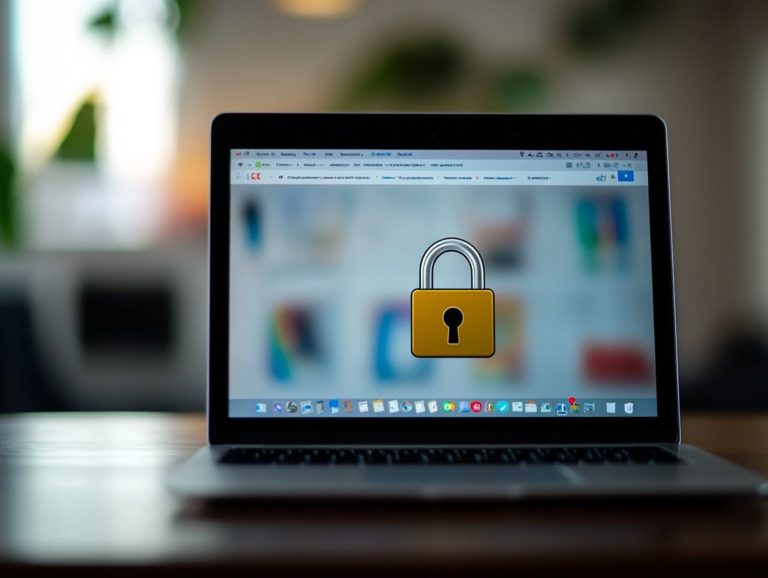how often should i update my software?
Software updates are crucial for sustaining the health and performance of your devices. They not only enhance functionality but also protect against security vulnerabilities that could jeopardize your data.
Recognizing the significance of software updates and the factors that determine how frequently they should be applied can profoundly influence your digital experience.
This article will delve into these aspects and offer practical tips for managing software updates effectively, ensuring your systems operate seamlessly and securely.
Contents
Key Takeaways:

- Keep your software up-to-date for optimal performance.
- Update frequency varies based on software type and security needs.
- Set a regular update schedule to avoid risks.
Understanding Software Updates
Understanding software updates is essential for maintaining peak performance and security across your devices be it your computer, smartphone, or tablet.
These updates form the backbone of a robust control system, ensuring that all operational software stays effective. They include critical updates and adjustments in hardware reviews, all of which can significantly elevate your user experience.
By embracing a proactive approach to software management, you can navigate the intricacies of automatic updates and testing cycles, reinforcing your IT support strategies.
What are Software Updates?
Software updates are essential modifications you should prioritize for your apps and operating systems. They enhance functionality, fix bugs, and bolster security.
These updates come in various forms, including major updates that introduce significant new features, minor updates that provide small enhancements, and crucial security patches updates that fix vulnerabilities in your software.
Understanding the distinctions between these types of updates is vital, as each serves a crucial role in maintaining the quality and efficiency of your critical software systems.
By regularly applying updates, you reinforce your security defenses and ensure that your software operates at peak performance, leading to a stable user experience.
Neglecting timely updates can leave your systems exposed to attacks and hinder their potential, ultimately impacting productivity and reliability.
Why are They Important?

Software updates are essential as they address security vulnerabilities, safeguard your data, and enhance your overall user experience.
These updates often include critical patches for known security flaws, significantly lowering the risk of attacks by cybercriminals. Consider the infamous Equifax breach in 2017 it starkly illustrated the severe consequences of neglecting updates. Don t wait until it s too late keep your software updated!
Organizations that quickly deployed updates, like those from Microsoft following the WannaCry ransomware attack, not only protected their data but also improved their system functionality.
Regular software updates refine user interfaces and introduce new features, ultimately leading to greater satisfaction and loyalty from users like you.
Factors to Consider for Update Frequency
Think about these key factors when deciding how often to update your software: the type of software in use, the existence of security vulnerabilities, and system compatibility. For more insights, you can explore the importance of software updates.
Each of these elements is essential in crafting a maintenance plan that aligns seamlessly with the operational needs of your technology environment.
For example, critical software applications may require a more aggressive update schedule to maintain strong security measures. In contrast, less critical software might adhere to a more flexible timeline based on user feedback and the capabilities of your IT support.
Type of Software
The type of software you choose greatly impacts how often updates occur and in what way. Important software, like antivirus programs, requires more frequent updates compared to standard business technology programs.
This necessity stems from the constantly shifting landscape of cybersecurity threats.
Antivirus programs must consistently refine their definitions and algorithms to identify and neutralize new vulnerabilities.
On the other hand, business technology applications such as project management tools or accounting software tend to receive updates less frequently. These updates are usually aimed at introducing new features or enhancing user experience rather than addressing immediate security concerns.
For example, an update to your accounting software might simplify reporting capabilities or incorporate new tax regulations. In contrast, updates for antivirus software primarily focus on strengthening defenses against emerging malware.
Recognizing these distinctions allows you to appreciate the priorities that shape software development and maintenance.
Security Vulnerabilities

Addressing security vulnerabilities is a primary motivation behind implementing timely software updates. These updates often contain vital security patches, which are updates that fix weaknesses in software to protect against attacks.
In fact, a staggering 60% of data breaches stem from unpatched vulnerabilities. This underscores the critical importance of keeping your software up to date.
Without these essential patches, your systems become increasingly vulnerable to attacks, putting sensitive data at risk and jeopardizing your organization s reputation.
IT support plays a crucial role in this endeavor, monitoring and managing updates to ensure that all software is refreshed promptly. By embracing this proactive approach, you can significantly mitigate risks and cultivate a safer operating environment for your organization.
System Compatibility
System compatibility is a pivotal consideration when planning software updates. Overlooking it can lead to significant operational disruptions.
Ensuring that various operating systems and software versions can seamlessly interact is essential.
When you address compatibility properly, you can streamline your update processes. This helps avoid those unexpected hiccups that tend to pop up at the worst times.
Incorporating comprehensive testing cycles into your maintenance plan is essential. These cycles empower your team to identify and resolve potential compatibility issues in advance, rather than scrambling to fix problems after deployment.
By prioritizing thorough testing, you minimize the risks associated with updates. This also cultivates a more efficient workflow, ultimately enhancing productivity and user satisfaction.
Determining the Right Update Schedule
Setting the right update schedule is vital for protecting your software and your business!
This schedule should be informed by a comprehensive analysis of best practices and tailored recommendations that align with your unique business technology needs.
Best Practices and Recommendations

Implementing best practices for updating software can profoundly enhance your security and streamline IT support efforts.
- Establish a robust configuration control process that meticulously documents and manages software versions.
- Regular audits are essential to ensure compliance and evaluate the effectiveness of updates. This allows you to swiftly identify any gaps and vulnerabilities.
- Investing in user training gives your employees the power to recognize update notifications and grasp the significance of timely installations.
By fostering a culture of awareness and responsibility, you strengthen your security posture and enhance overall operational efficiency. This ensures that systems remain up-to-date without causing undue disruption to daily activities.
Consequences of Not Updating Software
Neglecting to update your software can have serious repercussions. You may face heightened security risks, significant performance issues, and increased vulnerability to data breaches.
Staying current is not just a best practice; it’s essential for safeguarding your digital environment.
Don’t wait! Assess your software update schedule today to secure your systems.
Security Risks and Performance Issues
Neglecting software updates poses significant security risks and performance issues that should raise immediate concern. Outdated systems become easy prey for online attackers, who can exploit vulnerabilities with alarming ease.
When you allow software versions to lag, you miss out on essential security patches. This leaves your systems vulnerable to malware infections and data breaches that could compromise sensitive information.
Outdated systems also perform poorly; you could face frustrating slowdowns or unexpected crashes, which disrupt productivity and workflow.
This scenario underscores the critical importance of timely updates. Each new release not only strengthens security measures but also enhances system stability and efficiency. By diligently monitoring software updates, you can protect your business from potential threats and ensure a seamless user experience.
Tips for Managing Software Updates
Effectively managing software updates demands a strategically organized approach that weaves together various tips to streamline the process and keep you informed about the latest updates.
Streamlining the Process
Streamlining your software update process can dramatically reduce downtime and enhance IT support efficiency by implementing automatic updates and establishing clear protocols.
This strategy not only boosts productivity but also allows your organization to allocate resources more effectively. By leveraging automation, your teams can ensure that updates are deployed seamlessly, eliminating the need for constant manual oversight.
Establishing predefined protocols is crucial in minimizing disruptions during these critical updates. Utilizing staging environments test areas where updates can be checked before going live to test updates in advance can help you avoid unexpected issues in live settings.
It s equally important to prioritize system security by implementing robust checks and balances, ensuring that your software remains protected while updates are underway. By adopting this approach, you ll create a smoother and more reliable overall update experience.
Staying Informed About Updates
Staying informed about software updates is vital for safeguarding your data and maintaining the integrity of management systems across all your devices. To accomplish this, IT departments need to establish dependable methods for continuous monitoring and communication.
Regularly checking vendor websites, subscribing to newsletters, and setting up automated alerts are effective strategies that enable your team to swiftly identify new software releases or important security patches as they become available.
Creating an environment where team members actively share information about updates can significantly boost your organization s responsiveness. This ongoing dialogue not only keeps everyone in the loop but also highlights the critical need to act swiftly on updates, ensuring that potential vulnerabilities are addressed before they can be exploited.
Frequently Asked Questions
- How often should I update my software? It is recommended to update your software at least once every 3 months to ensure you have the latest features and security patches.
- Why is it important to update my software regularly? Updating your software regularly ensures that you have the latest bug fixes, security patches, and features. This helps to prevent any potential software issues and keeps your system running smoothly.
- What happens if I don’t update my software regularly? If you don’t update your software regularly, you may miss out on important bug fixes and security patches. This can leave your system vulnerable to cyber attacks and may cause performance issues.
- Can I set my software to update automatically? Yes, many software programs have an option to update automatically. This is a convenient way to ensure that your software is always up to date without having to manually check for updates.
- Should I update all of my software at the same time? It is not necessary to update all of your software at the same time. However, it is recommended to prioritize updating essential software, such as antivirus programs and operating systems.
- Do I need to update my software if I am not experiencing any issues? Yes, it is still important to update your software even if you are not experiencing any issues. Regular updates help to prevent potential issues and keep your system secure and running smoothly.
Stay proactive about your software updates to keep your systems secure!






